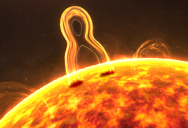Scientists Say They’ve Detected A “Heartbeat” From The Sun

Ok, listen, we’re not saying that there’s something alive on the sun that’s giving off a detectable “heartbeat.”
Scientists are saying that there’s some kind of signal coming from the sun, and they’re not really sure what’s sending it off.

Image Credit: iStock
Researchers from the New Jersey Institute of Technology (NJIT) discovered the series of “heartbeat”-like radio bursts coming from a solar flare thousands of miles above the Sun’s surface.
They detail the findings in their paper published in Nature Communications, but still are unsure exactly what caused them.

Image Credit: iStock
The team has pinpointed the location of the beating bursts to a C-class solar flare, which is a strong eruption of electromagnetic radiation.
“The discovery is unexpected. This beating pattern is important for understanding how energy is released and is dissipated in the Sun’s atmosphere during these incredibly powerful explosions.”
As with a majority of scientific discoveries, there are more questions than answers.
“However, the origin of these repetitive patterns, also called quasi-periodic pulsations, has long been a mystery and a source of debate among solar physicists.”
The data was actually collected by NJIT in 2017, and the pulses – known as quasi-periodic pulsations (QPP) – weren’t the first of their kind. The team also discovered similar QPP emanating from power flares on the Sun’s surface.

Image Credit: iStock
Power flares occur when sheets of electric currents break and reconnect to each other.
“This is the first time a quasi-periodic radio signal located at the reconnection region has been detected. This detection can help us to determine which of the two sources caused the other one.”
The believe is that analyzing this data will allow scientists to understand better these super powerful explosions.

Sign up to get our BEST stories of the week straight to your inbox.




